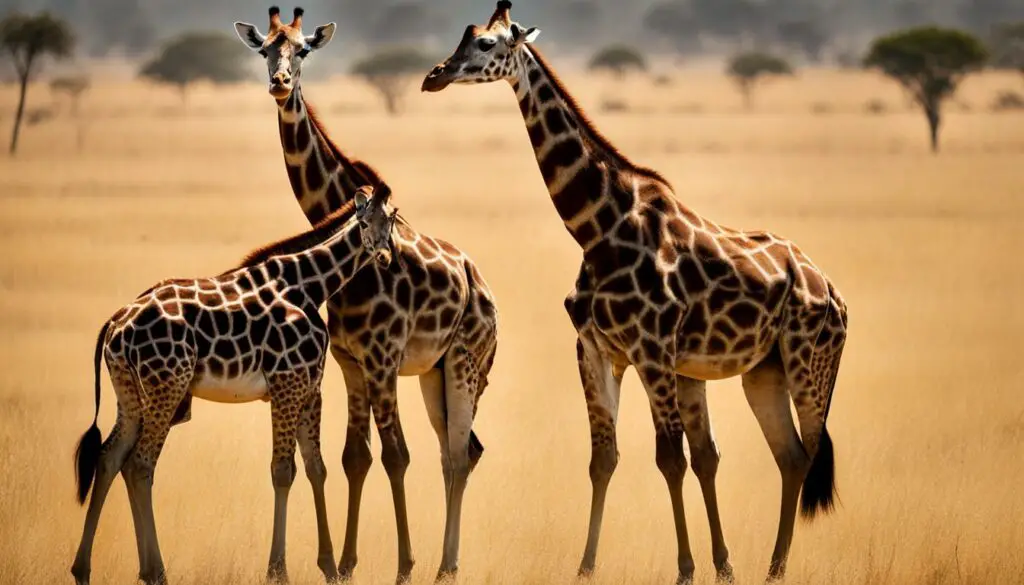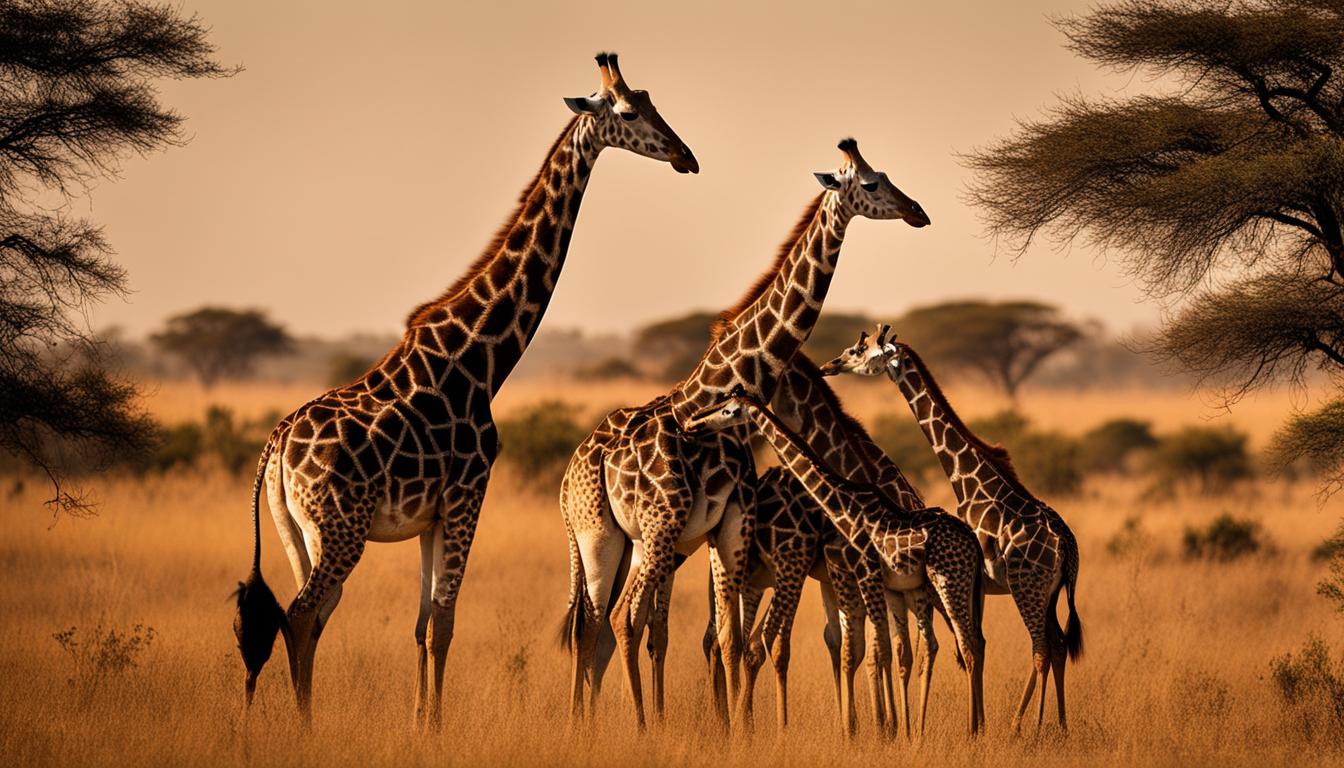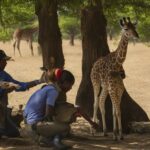When it comes to giraffes, their social structure is quite unique and fascinating. Unlike other social animals, giraffes do not form stable family groups. Instead, they have a social system known as “fission-fusion.” This means that their associations with other individuals vary from day to day. The variation in social preferences depends on factors such as habitat complexity, disturbance levels, and foraging behaviors.
Adult male giraffes form bachelor groups, while more mature males tend to spend most of their time alone. On the other hand, adult females choose social companions with similar dietary requirements. Nursery groups, which consist of mothers and calves of similar ages, may keep the same members for several months.
Giraffes are known for their interesting herd dynamics and social interactions. While they do not have a strict social hierarchy, dominant adult males have the privilege of mating with an entire herd of giraffes. Young males, on the other hand, form bachelor herds and engage in necking battles to establish dominance.
Giraffes have specific daily routines. They prefer to feed in the morning and afternoon to maximize visibility and be aware of predators. With their unique feeding adaptation, using their long necks and 18-inch tongues, giraffes can consume hundreds of pounds of leaves per week. Resting positions vary from standing still to lying on the ground with their legs bent. Young giraffes often rest with their bodies on the ground and their necks supported by one of their hind legs.
While giraffes are not known for their vocalizations, they do communicate through sounds in certain situations. Males emit cough-like vocalizations during courtship, and both males and females can whistle, moan, and communicate through infrasounds at long distances. Additionally, nonverbal communication through body movements plays a vital role in giraffe herds.
Giraffes have unique physical characteristics that make them stand out. They are the tallest land animals, with females reaching up to 14 feet and males up to 18 feet in height. Their necks alone can be 6 feet long, and their legs are also about 6 feet long. Giraffes have a spotted pattern similar to that of a leopard and two horns called ossicones.
These incredible creatures can be found in various habitats across African savannas, grasslands, and woodlands. They are native to many African countries, including Kenya, Cameroon, Chad, Niger, Uganda, Namibia, Botswana, Zimbabwe, Zambia, Tanzania, Angola, and South Africa.
When it comes to reproduction, giraffes have a gestation period of about 14 months, and adult females usually give birth to one calf at a time. Calves can stand and walk within hours of birth, and they are often left in nursery groups while the mothers go out to eat and socialize.
It is essential to protect giraffes and their habitats as they face numerous threats, including habitat loss, overgrazing, and poaching. Organizations like the World Wildlife Foundation and the San Diego Zoo are working hard to conserve giraffes and raise awareness about their conservation needs. By supporting these efforts, we can help ensure the future of these majestic creatures.
Giraffe Group Behavior and Social Hierarchy
Giraffes have a distinct social structure that involves group behavior and a loose social hierarchy. Unlike some other animal species, giraffes do not have a strict dominance hierarchy within their herds. However, dominant adult males have the privilege of mating with an entire herd of giraffes. Young males, on the other hand, form bachelor herds and engage in necking battles to establish dominance.
Giraffes are known for their unique feeding behavior, preferring to feed in the morning and afternoon hours to maximize visibility and be aware of potential predators. When food is scarce, large herds may split and travel on their own to find resources. This behavior allows giraffes to adapt to their environment and ensure their survival.
To understand the social organization of giraffes, it is important to consider their feeding behavior. Giraffes have the ability to consume hundreds of pounds of leaves per week, thanks to their long necks and 18-inch tongues. Adult females tend to choose social companions with similar dietary requirements, allowing them to forage together and share food resources. This social preference based on dietary needs is an important aspect of giraffe social organization.
Giraffe Group Behavior and Social Hierarchy
| Social Behavior | Description |
|---|---|
| Mating | Dominant adult males have the privilege of mating with an entire herd of giraffes. |
| Bachelor Herds | Youthful males form bachelor herds and engage in necking battles to establish dominance. |
| Feeding Behavior | Giraffes prefer to feed in the morning and afternoon hours to maximize visibility and be aware of predators. When food is scarce, large herds may split and travel on their own to find resources. |
| Dietary Preferences | Adult females tend to choose social companions with similar dietary requirements, allowing them to forage together and share food resources. |
Giraffes’ unique social hierarchy and group behavior play a crucial role in their survival and adaptation to their environment. While they may not have a strict dominance hierarchy, their social interactions and feeding preferences contribute to their overall social organization.
Giraffe Communication and Vocalizations
Giraffes may not be known for their vocalizations, but they do have various ways of communicating with each other. Males, especially during courtship, emit cough-like vocalizations to attract females. They also use infrasounds, which are sounds below the range of human hearing, to communicate over long distances. Both males and females can whistle and moan, using these vocalizations to convey information to other giraffes in their herd.
Interestingly, giraffes also rely on nonverbal communication through body movements. They use their long necks to signal dominance or submission. For example, a giraffe may lower its head and extend its neck towards another giraffe as a sign of aggression. In contrast, a giraffe that is trying to show submission may lower its head and tuck its chin against its chest.
“Giraffes may not have the most diverse vocal repertoire, but their nonverbal communication is fascinating to observe. From neck movements to subtle postures, they have developed unique ways to communicate within their herds.”
Giraffe Vocalizations:
- Cough-like vocalizations during courtship
- Whistling and moaning for communication
- Infrasounds for long-distance communication
Giraffes also use vocalizations to protect their young. Offspring and young giraffes are known to produce loud sounds when they are in danger, signaling the presence of predators to their mothers and other members of the herd. This communication helps to ensure the safety of the group and allows them to respond quickly to potential threats.
Overall, while giraffes may not be as vocal as some other animals, they have developed a range of communication methods, both verbal and nonverbal, to navigate their social interactions and ensure the well-being of their herds.

Giraffe Behavior and Daily Routines
Understanding giraffe behavior and their daily routines provides valuable insights into the lives of these majestic creatures. While their social structure and communication have been discussed in previous sections, this section will focus on how giraffes spend their time and the habits they develop.
Giraffes are primarily herbivores and spend a significant portion of their day feeding. Their unique feeding adaptation, including their long necks and 18-inch tongues, allows them to browse on leaves high up in trees. In fact, they can consume hundreds of pounds of leaves per week. Giraffes prefer to feed in the morning and afternoon, taking advantage of increased visibility and actively avoiding predators.
Rest is also an important aspect of giraffe behavior. They have various resting positions, including standing still, lying on the ground with their legs bent, and young giraffes resting with their bodies on the ground and their necks supported by one of their hind legs. These resting positions not only provide physical relaxation but also allow them to conserve energy and be alert to potential dangers.
| Activity | Duration |
|---|---|
| Feeding | 6-8 hours |
| Resting | 4-5 hours |
| Socializing | 1-2 hours |
| Moving/Traveling | 1-2 hours |
“Giraffes spend a significant portion of their day feeding, consuming hundreds of pounds of leaves per week.”
Giraffes are not territorial animals, but they can exhibit more territorial behavior during mating and when food resources become scarce. Males may compete for access to females, engaging in necking battles to establish dominance. This behavior highlights the importance of mating and survival in the giraffe’s daily routine.
In summary, giraffes have a well-defined daily routine that revolves around feeding, resting, socializing, and mating. Their specialized feeding adaptations and rest positions are essential for their survival in their natural habitats. Understanding these behaviors enhances our appreciation for these magnificent animals and the unique challenges they face.
Giraffe Appearance and Physical Characteristics
When it comes to physical characteristics, giraffes are truly remarkable creatures. Standing as the tallest land animals, females can reach heights of up to 14 feet, while males can grow even taller, measuring up to an impressive 18 feet. Their long necks alone can stretch up to 6 feet in length, allowing them to reach leaves high up in the trees.
Giraffes have a distinct spotted pattern on their coats, similar to that of a leopard, which varies in colors and patterns depending on their subspecies and the habitat they inhabit. Additionally, they possess a hump on their back, much like a camel, which adds to their unique appearance.
A notable feature of giraffes is the presence of two horns called ossicones. Unlike other animals, both males and females have ossicones, which are made of cartilage and are covered in skin. These structures play a role in male-male combat during necking battles, where they swing their necks to strike their opponent, using their ossicones as weapons.
| Physical Characteristics | Measurements |
|---|---|
| Height (males) | Up to 18 feet |
| Height (females) | Up to 14 feet |
| Neck length | Up to 6 feet |
| Coat pattern | Spotted, varies by subspecies |
| Horns (ossicones) | Present in both males and females |
Giraffes are truly a sight to behold, with their towering height, distinctive patterns, and unique physical adaptations. Their appearance is not only an adaptation for survival but also a testament to the beauty and diversity of the animal kingdom.
Giraffe Habitat and Geography
Giraffes can be found in various habitats across the African continent, including savannas, grasslands, and woodlands. They have adapted to live in diverse environments, from arid regions to areas with abundant vegetation. The specific habitat preferences of giraffes depend on factors such as food availability, water sources, and suitable living conditions.
Their range extends across multiple African countries, including Kenya, Cameroon, Chad, Niger, Uganda, Namibia, Botswana, Zimbabwe, Zambia, Tanzania, Angola, and South Africa. Giraffes are well-suited to living in these regions due to their unique physical characteristics and behavioral adaptations. Their long legs and necks allow them to reach higher food sources, while their keen eyesight helps them spot potential predators in the vast landscapes.
Table:
| African Countries | Giraffe Population |
|---|---|
| Kenya | 13,000-15,000 |
| Tanzania | 36,000-41,000 |
| South Africa | 6,500-7,000 |
| Namibia | 9,000-9,400 |
“Giraffes are highly adaptable creatures, able to thrive in a range of habitats across Africa. Their ability to browse on leaves high above the ground allows them to access food sources that other herbivores cannot reach. However, habitat loss and fragmentation pose significant challenges to giraffe populations, and conservation efforts are crucial to ensure their survival in the future.” – Wildlife Conservation Society
Giraffe habitats are under threat from various factors, including human encroachment, deforestation, and climate change. As human populations expand and agricultural activities increase, giraffes face shrinking habitats and limited access to food and water sources. Additionally, illegal hunting and poaching for their meat, hides, and body parts further endanger giraffe populations.
Efforts are underway by conservation organizations, local communities, and governments to protect giraffe habitats and promote sustainable practices. These initiatives focus on creating protected areas, implementing anti-poaching measures, and raising awareness about the importance of giraffe conservation. By supporting these efforts, we can help safeguard the future of these iconic and majestic animals.
Giraffe Breeding and Reproduction
Giraffes have a unique breeding and reproduction process that is essential for the survival and growth of their populations. Adult females, known as cows, usually give birth to one calf at a time after a gestation period of approximately 14 months. The birthing process is quite remarkable, with the calf being born feet first, which helps protect its head and vital organs during delivery. Within a few hours of birth, the newborn calf can stand and walk, displaying their impressive coordination and strength.
Once the calf is born, the mother leaves it in the care of a nursery group, consisting of other adult females and their calves. This group acts as a collective babysitting unit, where one adult stays behind to watch over the young while the others go out to feed and socialize. This communal approach to childcare allows the calves to receive the attention and protection they need while giving the mothers the opportunity to fulfill their own physiological needs.
The nursing period for giraffe calves lasts for six to nine months, during which they rely solely on their mother’s milk for sustenance. However, they start sampling vegetation at around four months old, gradually transitioning to a diet of leaves and other plant matter. This gradual weaning process prepares the calves for independence and the challenges they will face as they grow older.
Giraffe Breeding and Reproduction Statistics
| Giraffe Age | Reproductive Stage | Key Milestones |
|---|---|---|
| Birth to 3 years | Infancy | Mother’s care and protection |
| 3 to 5 years | Sexual Immaturity | Growth and development |
| 5+ years | Sexually Mature | Potential for reproduction |
Male giraffes, called bulls, reach sexual maturity between 3 and 5 years of age, while females mature slightly earlier. Once they reach this stage, they are ready to engage in breeding activities. Dominant bulls have the privilege of mating with multiple females in the herd, ensuring the continuation of their genetic lineage. This mating process helps maintain genetic diversity within giraffe populations and contributes to their overall reproductive success.
Understanding the breeding and reproduction behavior of giraffes is crucial for conservation efforts aimed at protecting these magnificent creatures. By studying their reproductive patterns and implementing effective management strategies, we can help ensure the continued growth and well-being of giraffe populations in the wild.
Conclusion
The social structure of giraffes is truly fascinating, showcasing their ability to adapt and survive in the wild. However, these magnificent creatures are currently facing numerous threats that jeopardize their future. The conservation of giraffes and their habitats is of utmost importance to ensure their continued existence.
Habitat loss due to human activities poses a significant challenge to giraffe populations. As human populations expand and demand for land increases, giraffes often lose their natural habitats, leading to fragmentation and decreased access to food and water sources.
In addition to habitat loss, overgrazing by livestock and poaching for their meat, hides, and bones are also major threats to giraffes. The illegal wildlife trade further exacerbates these problems, putting immense pressure on already vulnerable giraffe populations.
Thankfully, there are dedicated organizations like the World Wildlife Fund and the San Diego Zoo that are actively working towards giraffe conservation. These organizations focus on research, habitat protection, community involvement, and raising awareness about the importance of preserving giraffes and their ecosystems.
By supporting these conservation efforts and spreading awareness about the plight of giraffes, we can contribute to securing a brighter future for these majestic creatures. Let us come together to protect their habitats, fight against poaching, and ensure that giraffes can continue to grace the African savannas for generations to come.
How does a Giraffe’s Tongue Aid in their Social Interactions?
The giraffe’s tongue length and usage play a crucial role in their social interactions. With a tongue that can reach up to 18 inches, they use it skillfully to groom themselves and clean their ears. Additionally, during interactions like social licking, giraffes’ tongues help establish bonds among herd members, contributing to their social cohesion and communication within the group.
FAQ
What is the social structure of giraffe herds and families?
Giraffes have a unique social structure known as “fission-fusion.” They do not form stable family groups like other social animals. Instead, they vary the individuals they associate with from day to day. Adult males form bachelor groups, while more mature males spend most of their time alone. Adult females tend to choose social companions with similar dietary requirements. Nursery groups, consisting of mothers and calves of similar ages, may keep the same members for several months.
How do giraffes form social hierarchies?
Giraffes do not have a strict social hierarchy like some other animal species. However, dominant adult males have the privilege of mating with an entire herd of giraffes. Young males form bachelor herds and engage in necking battles to establish dominance. Giraffes prefer to feed in the morning and afternoon hours and rest in various positions. When food is scarce, large herds may split and travel on their own to find resources.
How do giraffes communicate with each other?
Giraffes are not known for their vocalizations, but they do communicate through sounds in certain situations. Males emit cough-like vocalizations during courtship, and both males and females can whistle, moan, and communicate through infrasounds at long distances. Offspring and young giraffes make loud sounds when in danger, signaling the presence of predators to their mothers. Nonverbal communication through body movements is also important in giraffe herds.
What are the daily routines and behavior of giraffes?
Giraffes prefer to feed in the morning and afternoon to maximize visibility and be aware of predators. They can consume hundreds of pounds of leaves per week and have a unique feeding adaptation with their long necks and 18-inch tongues. Giraffes rest in various positions, including standing still, lying on the ground with their legs bent, and young giraffes resting with their bodies on the ground and necks supported by one of their hind legs. They are not territorial animals, but males can become more territorial during mating and scarce food conditions.
What are the physical characteristics of giraffes?
Giraffes are the tallest land animals, with females reaching up to 14 feet and males up to 18 feet in height. Their necks alone can be 6 feet long, and their legs are also about 6 feet long. They have a hump on their back like a camel and a spotted pattern similar to that of a leopard. Giraffes have two horns called ossicones, which both males and females possess. They vary in coat patterns and colors depending on their subspecies and habitat.
Where do giraffes live and what is their habitat preference?
Giraffes can be found in African savannas, grasslands, and woodlands. They are native to many African countries, including Kenya, Cameroon, Chad, Niger, Uganda, Namibia, Botswana, Zimbabwe, Zambia, Tanzania, Angola, and South Africa. Their habitat preferences depend on the availability of food resources and suitable living conditions.
How do giraffes reproduce and raise their young?
The gestation period for giraffes is about 14 months, and adult females usually give birth to one calf at a time. Calves are born feet first and can stand and walk within hours of birth. Mothers leave their young in nursery groups, where one adult stays to babysit while others go out to eat and socialize. Calves can start sampling vegetation at around four months old but continue to nurse until they are six to nine months old. Giraffes reach sexual maturity between 3 and 5 years of age.
What are the threats to giraffes and how can they be protected?
Giraffe populations are facing threats such as habitat loss, overgrazing, and poaching. Conservation efforts led by organizations like the World Wildlife Foundation and the San Diego Zoo are working to protect giraffes and their habitats. By supporting these efforts and raising awareness about giraffe conservation, we can help ensure the future of these majestic creatures.







